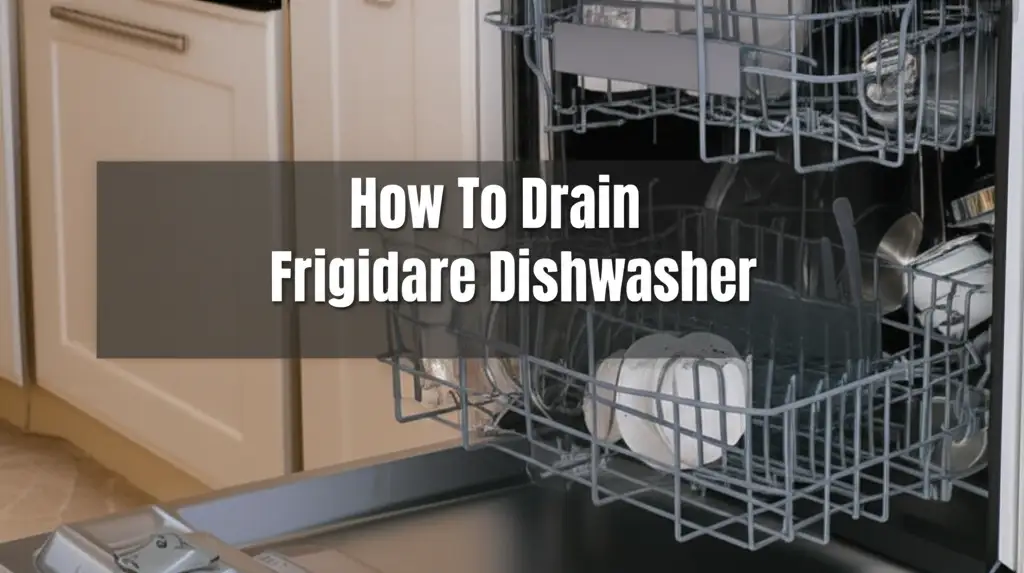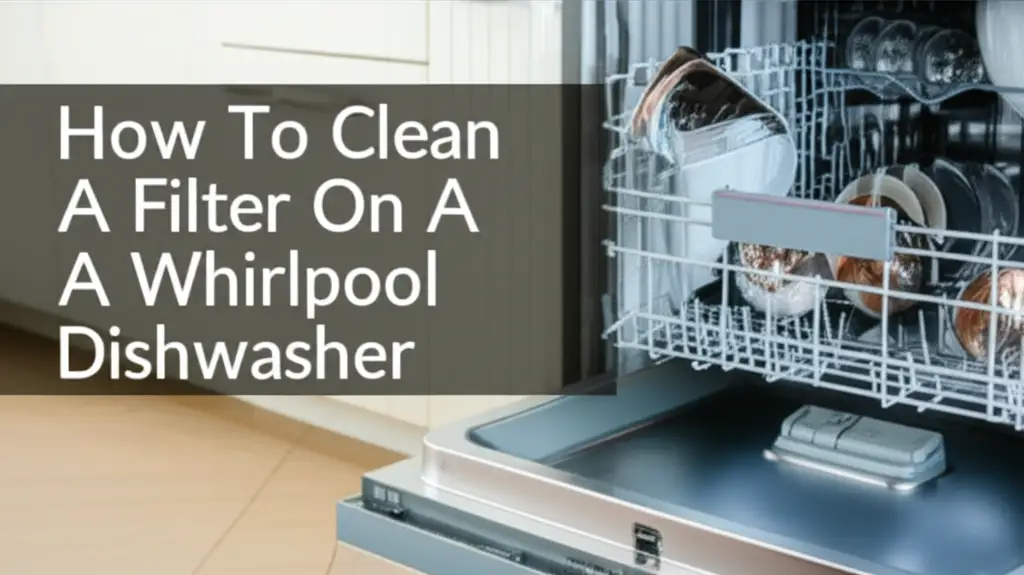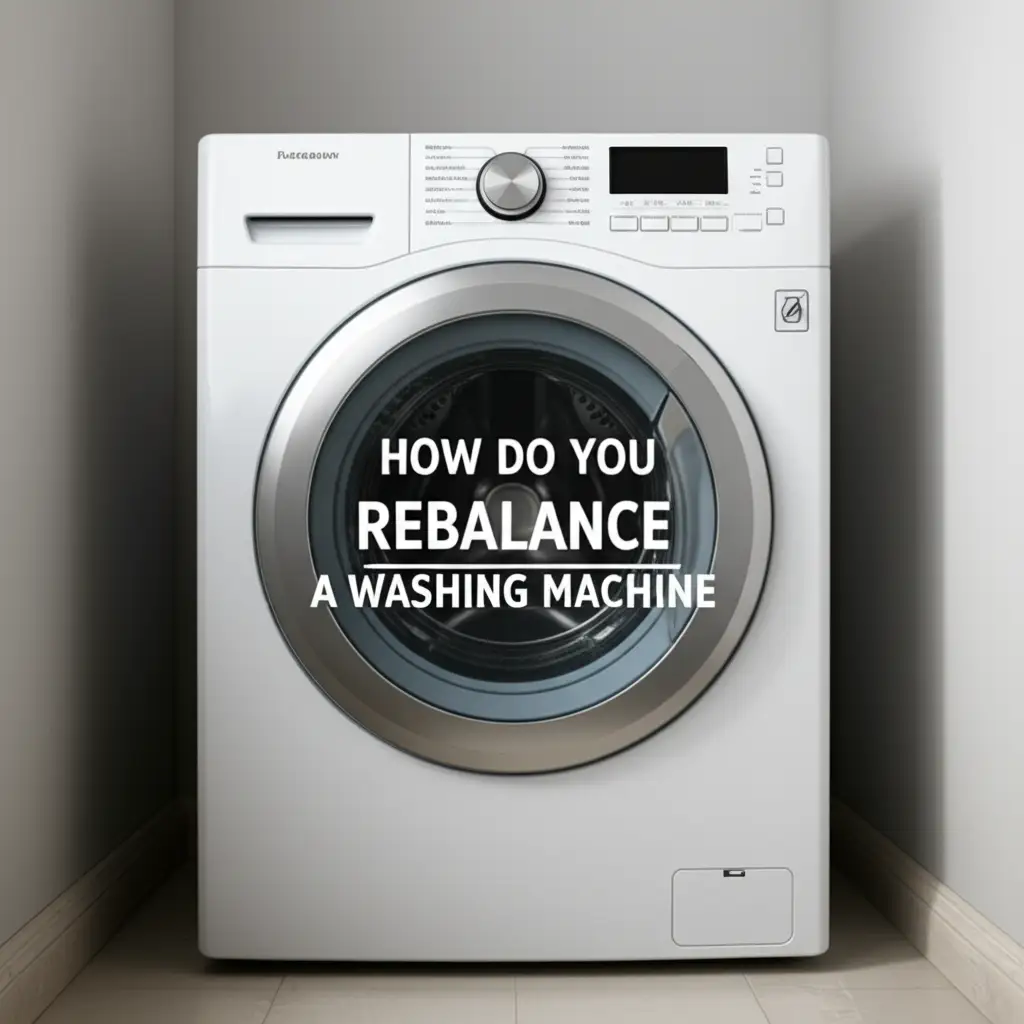· Tessa Winslow · Appliance Maintenance · 18 min read
How To Drain Frigidaire Dishwasher

How to Drain Your Frigidaire Dishwasher: A Complete Troubleshooting Guide
Is your Frigidaire dishwasher refusing to drain? You open the door, expecting sparkling clean dishes, but instead, you find a pool of murky water sitting at the bottom. This situation is frustrating. It can also be unhygienic. Learning how to drain your Frigidaire dishwasher is a common need for homeowners. This guide helps you understand why your dishwasher is not draining. It gives you clear, actionable steps to fix the problem yourself. We will cover everything from basic troubleshooting to more specific component checks. You can get your dishwasher working properly again.
Takeaway
- Always disconnect power before working on your dishwasher.
- Manually remove standing water with cups and towels.
- Regularly clean the dishwasher filter to prevent clogs.
- Check the drain hose for kinks and blockages.
- Ensure your air gap and garbage disposal are clear.
- A faulty drain pump often requires professional help.
If your Frigidaire dishwasher is full of standing water, you need to drain it. First, turn off the power at the circuit breaker. Then, manually scoop out as much water as possible using a cup. Use towels to absorb the remaining water. This makes it safe to check for clogs in the filter or drain hose.
Understanding Why Your Frigidaire Dishwasher Won’t Drain
A Frigidaire dishwasher failing to drain is a common issue. Several factors can cause this problem. Understanding these causes helps you find the right solution. Most drain problems come from blockages or mechanical failures.
One primary reason for a dishwasher not draining is a clogged filter. Food particles, grease, and debris accumulate in the filter over time. This buildup stops water from flowing freely into the drain pump. A dirty filter is a quick fix. I always check this first.
The drain hose can also cause problems. This hose carries water from the dishwasher to your sink drain or garbage disposal. Kinks, twists, or internal blockages in the hose prevent proper draining. Sometimes, a blocked drain hose connects to your home’s main plumbing. This can be a bigger issue. You need to ensure the entire line is clear. Learning how to get the dishwasher to drain involves checking this hose carefully.
Issues with the garbage disposal can affect drainage. If your dishwasher connects to a garbage disposal, the disposal must be clear. New garbage disposals have a knockout plug. If this plug is not removed during installation, your dishwasher will not drain. Food debris in an existing disposal also stops water flow. It is important to ensure your garbage disposal is empty and running correctly.
Finally, a malfunctioning drain pump can be the culprit. The drain pump is responsible for forcing water out of the dishwasher. If the pump is faulty, damaged, or has an object stuck in it, it cannot push water out. This often leads to water pooling at the bottom of the tub. Identifying a bad pump can be tricky without specific tools. We will discuss pump issues more later. You might need professional help for pump replacement.
Safety First: Preparing to Drain Your Dishwasher
Safety is the most important step before you start any work on your Frigidaire dishwasher. Working with electricity and water carries risks. Ignoring safety precautions can lead to electric shock or serious injury. Always prioritize your well-being.
The first step is to disconnect the power supply to your dishwasher. You can do this at your home’s circuit breaker box. Find the breaker labeled for your kitchen or dishwasher. Flip it to the “off” position. This stops electricity from reaching the appliance. Do not simply turn off the dishwasher with its power button. That button only controls the operation, not the direct power supply. A proper power disconnection ensures you are safe while you work. I always double-check by trying to turn the dishwasher on after flipping the breaker.
Next, you need to shut off the water supply. There is usually a shut-off valve under the sink. This valve connects to the dishwasher’s water inlet hose. Turn the handle clockwise until it is tight. This stops water from entering the dishwasher. Turning off the water prevents spills when you disconnect hoses. It also ensures no more water fills the tub while you are trying to drain it.
Prepare your workspace. You will likely encounter standing water. Place old towels or absorbent rags around the base of the dishwasher. This protects your floor from spills. Have a bucket or large bowl ready to collect water. You will use this to manually remove water from the dishwasher tub. Wearing gloves can also be a good idea. This protects your hands from dirty water and sharp edges inside the dishwasher. Taking these precautions ensures a safer and cleaner repair process. When you need to drain dishwasher water manually, these steps are crucial. They set the stage for safe troubleshooting.
Manually Draining Standing Water from Your Frigidaire Dishwasher
Before you can fix the reason your Frigidaire dishwasher is not draining, you must remove the standing water. This makes the dishwasher safe to work on. It also gives you better access to internal components. Manually draining the water is a straightforward process.
First, make sure the power and water supply are off. I mentioned this in the safety section. This is a critical step. Failing to do this can be dangerous. Once confirmed, open the dishwasher door. You will see the water pooled at the bottom.
Use a small cup or scoop to remove most of the water. Slowly ladle the water out of the dishwasher tub. Pour the collected water into a bucket or a nearby sink. Be patient with this step. Do not rush it. Trying to scoop too quickly can cause spills. Continue until you have removed as much water as possible using the cup. This is the bulk removal stage. It clears the main volume of water.
After scooping, some water will still remain. It usually forms a thin layer. Use old towels or sponges to soak up the rest. Place towels directly into the bottom of the dishwasher. Let them absorb the remaining water. Wring them out into your bucket or sink. Repeat this process until the bottom of the dishwasher tub is dry. This step ensures you have a clean and dry work area. It also prevents water from dripping when you start pulling out parts.
This manual draining process prepares your Frigidaire dishwasher for troubleshooting. With the water gone, you can safely access the filter, drain hose, and pump. Remember, do not skip this step. It is the foundation for any further repair work. For more detailed instructions on how to drain dishwasher water manually, you can refer to specialized guides.
Checking and Cleaning the Frigidaire Dishwasher Filter
A clogged filter is one of the most common reasons a Frigidaire dishwasher won’t drain. Regularly cleaning this filter can prevent many issues. Your dishwasher filter traps food particles. This stops them from recirculating and causing clogs in the drain pump. I often find this to be the simplest fix.
To access the filter, open your dishwasher door. Look at the bottom of the tub. Frigidaire dishwashers typically have a cylindrical filter assembly. It usually consists of two parts: a coarse filter and a fine filter. The coarse filter is a larger cup-like screen. The fine filter is a mesh cylinder inside or around it. Knowing where is the filter on Frigidaire dishwasher helps you locate it quickly.
To remove the filter, twist the upper part of the cylindrical assembly counter-clockwise. This usually unlocks it. Lift the entire assembly straight up and out of the dishwasher. You might need to gently wiggle it. Once the main filter is out, separate the coarse and fine filters if they are not already apart. Some models may have a flat filter at the bottom that also needs removal. Consult your owner’s manual if you are unsure about your specific model.
Now, it is time to clean the filter. Take the filter components to a sink. Rinse them thoroughly under warm running water. Use a soft brush, like an old toothbrush, to gently scrub away any stuck-on food debris, grease, or other gunk. Pay close attention to the mesh screens. Ensure all holes are clear. Avoid using harsh chemicals or abrasive scrubbers, as these can damage the filter material. I usually see a lot of food bits here. It is surprising how much collects.
After cleaning, reassemble the filter components. Insert the filter assembly back into the dishwasher. Twist it clockwise to lock it securely into place. Make sure it sits flush with the bottom of the tub. A loosely installed filter can cause problems. Cleaning your filter every few months or whenever you notice draining issues is a good practice. Knowing how often should you clean your dishwasher filter can save you from future headaches.
Inspecting and Clearing the Dishwasher Drain Hose
Even if your filter is clean, a blocked or kinked drain hose can prevent your Frigidaire dishwasher from draining. The drain hose is a crucial component. It carries the dirty water out of the appliance. Checking this hose involves a few steps, and it might require pulling the dishwasher out.
First, locate the drain hose. It is typically a ribbed, corrugated plastic hose. It connects to the back of your dishwasher at one end. The other end connects to your sink drain, garbage disposal, or an air gap. You might need to carefully pull the dishwasher out from under the counter to access the back. Be gentle to avoid damaging flooring or other connections. Remember to ensure power and water are off.
Once you find the hose, inspect its entire length. Look for any visible kinks or sharp bends. These can easily restrict water flow. Straighten out any kinks you find. Sometimes, simply repositioning the dishwasher can solve the problem if the hose was bent during installation or movement. Check for a sag in the hose that allows water to pool, creating a water trap. This can slow or stop draining.
If there are no visible kinks, the blockage might be internal. Disconnecting the hose allows for better inspection. You will usually need a screwdriver or pliers to loosen clamps at both ends of the hose. Have a bucket ready, as some water might spill when you disconnect it. Once disconnected, inspect both ends for debris. You can try to clear the hose by running water through it from a sink. If water does not flow freely, you have a blockage.
To clear an internal blockage, you can use a long, thin brush or a straightened coat hanger. Gently push it through the hose to dislodge any obstructions. Be careful not to puncture the hose. For stubborn clogs, you might need to use a shop vac to suck out the debris. Alternatively, a plumbing snake designed for small drains can work. Once clear, reconnect the hose securely. Ensure all clamps are tightened. Double-check for any new kinks as you push the dishwasher back into place. Clearing your drain hose is a common step for how to clear dishwasher drain line issues.
Addressing the Air Gap and Garbage Disposal Connections
The way your Frigidaire dishwasher connects to your home’s drainage system can affect its ability to drain. This usually involves an air gap or a direct connection to a garbage disposal. Both need to be clear for proper function. I find these connections are often overlooked.
An air gap is a small cylindrical device mounted on your kitchen sink or countertop. It acts as a backflow prevention device. Water from the dishwasher enters the air gap, flows through it, and then drains into the sink or garbage disposal. If the air gap gets clogged, water cannot flow through it properly. This causes it to back up into the dishwasher. To check your air gap, remove its chrome cap. You might need to twist it or pry it off. Then, remove the inner plastic cap. Look for any debris, like food particles or mineral buildup. Clear any blockages you find. You can use a small brush or a toothpick. Also, check the hoses connected to the air gap for clogs.
If your dishwasher drains into a garbage disposal, the disposal itself must be clear. A common issue is a full or jammed garbage disposal. Before running the dishwasher, always run your garbage disposal for a few seconds. Do this with cold water. This clears any food debris that could obstruct the dishwasher’s drain line. If you hear the disposal humming but not grinding, it might be jammed. Use an Allen wrench in the bottom center hole of the disposal to free the motor.
Another critical point for garbage disposal connections is the knockout plug. When a new garbage disposal is installed, it has a plug in the dishwasher inlet port. This plug must be “knocked out” to allow water to drain from the dishwasher. If this plug was not removed during installation, your dishwasher will never drain properly. You would need to disconnect the dishwasher drain hose from the disposal. Then, use a hammer and screwdriver to knock out the plug from inside the disposal unit. Reconnect the hose securely after removal. Proper connection is key to preventing problems, especially if you are connecting a dishwasher drain to a garbage disposal.
Troubleshooting the Dishwasher Drain Pump
If you have checked the filter, the drain hose, and the air gap/garbage disposal, the problem might lie with the drain pump. The drain pump is a motor that expels water from the dishwasher tub. A faulty drain pump means your Frigidaire dishwasher simply cannot push water out. This is a more serious issue.
First, listen for the pump. During the drain cycle, you should hear a humming or whirring sound. If you hear nothing, or if you hear a grinding noise, the pump may be failing or obstructed. You can try to reset the dishwasher by turning off its power at the circuit breaker for a few minutes. Sometimes, a temporary glitch can cause the pump to stop.
If resetting does not work, you might need to inspect the pump directly. This requires more disassembly. The drain pump is usually located at the bottom of the dishwasher, near the motor. You might need to pull the dishwasher out and tilt it on its back. Some models allow access from the front by removing the lower access panel. Once you locate the pump, look for any visible obstructions. Small pieces of glass, food, or even a twisted piece of plastic can jam the impeller inside the pump. You may need to carefully remove the pump motor assembly. Be cautious, as there might be sharp edges.
Testing the pump’s electrical resistance with a multimeter can tell you if it is receiving power or if its motor winding is faulty. For a drain pump, you are checking for continuity and specific ohm readings. If you are not comfortable with electrical testing, it is best to consult a professional. Knowing how many ohms should a dishwasher drain pump have requires technical knowledge.
If the pump is jammed, clear the obstruction. If the pump is not receiving power, check the wiring connections. If the pump runs but nothing drains, its impeller might be damaged. If the pump shows no signs of life and no obstructions are found, it likely needs replacement. Replacing a drain pump can be a complex task. It often requires specific tools and technical know-how. For this reason, many homeowners choose to call a qualified appliance technician. A professional can diagnose the pump issue accurately. They can also install a new pump correctly.
Preventing Future Frigidaire Dishwasher Drain Problems
Prevention is always better than cure. Following simple maintenance steps can significantly reduce the chances of your Frigidaire dishwasher having draining issues in the future. Small habits make a big difference in appliance longevity. I find these steps save me time and frustration.
Scrape Plates Thoroughly: Before loading dishes into the dishwasher, scrape off all large food particles. While dishwashers are designed to handle some food residue, excessive amounts can quickly clog the filter and drain pump. Think of it like a pre-rinse for your dishes, but without using water. Just scrape solids into the trash or compost. This simple step is probably the most impactful. It stops most debris from entering the drain system.
Regular Filter Cleaning: Make cleaning your dishwasher filter a routine task. Depending on how often you use your dishwasher and how much food debris your family generates, you might need to clean it monthly or every few weeks. Refer back to the section on cleaning the filter for detailed steps. A clean filter is the first line of defense against clogs. This helps your Frigidaire dishwasher drain properly every time.
Run Garbage Disposal Before Dishwasher: If your dishwasher drains into a garbage disposal, always run the disposal for a few seconds before starting the dishwasher cycle. This clears any food waste that might be sitting in the disposal. Such waste could otherwise back up into the dishwasher’s drain line. Use cold water when running the disposal. This helps solidify any grease or oil, making it easier to grind and flush away.
Check Drain Hose for Kinks: Periodically pull your dishwasher slightly forward to inspect the drain hose. Ensure it is not kinked or crimped. These small bends can slowly restrict water flow over time. Keeping the hose straight allows for proper drainage. Also, ensure the hose has a high loop. A high loop prevents dirty water from the sink from flowing back into the dishwasher. Most installation guides recommend this.
Use the Right Detergent: Use only dishwasher-specific detergent. Using too much detergent or the wrong type (like dish soap) can create excessive suds. These suds can overflow, clog the drain lines, and even damage the pump. Always follow the manufacturer’s recommendations for detergent type and amount. Also, consider using a dishwasher cleaner product periodically. These cleaners help dissolve grease and mineral buildup in the internal components. This ensures clear pipes and a healthy appliance. For tips on how to use dishwasher cleaner, specific products are available.
Frequently Asked Questions About Draining Frigidaire Dishwashers
Why is my Frigidaire dishwasher not draining completely?
Your Frigidaire dishwasher might not drain completely due to a clogged filter, a kinked or blocked drain hose, or a problem with your garbage disposal or air gap. A malfunctioning drain pump is also a common cause. Always check the easiest solutions first, like cleaning the filter.
Can I use a plunger to drain my dishwasher?
No, using a plunger on your dishwasher is not recommended. The force from a plunger can damage internal components, hoses, or seals. It might also push debris further into the system, making the clog worse. Always use manual methods or clear specific parts.
How often should I clean my Frigidaire dishwasher drain filter?
It is a good practice to clean your Frigidaire dishwasher’s drain filter at least once a month. If you frequently wash dishes with a lot of food debris, you might need to clean it more often, perhaps every two weeks. Regular cleaning prevents clogs and ensures efficient draining.
What if my dishwasher still won’t drain after troubleshooting?
If your dishwasher still won’t drain after checking the filter, drain hose, air gap, and garbage disposal, the issue is likely with the drain pump or main control board. These repairs are more complex. It is best to contact a qualified appliance technician for diagnosis and repair.
Is there a reset button for Frigidaire dishwasher drain issues?
Frigidaire dishwashers do not have a specific “reset button” for drain issues. You can try a general power reset. Turn off the dishwasher’s power at the circuit breaker for 5-10 minutes. Then, turn it back on. This can sometimes clear minor electronic glitches.
How do I know if my drain pump is bad?
You might suspect a bad drain pump if you hear no humming sound during the drain cycle, or if you hear a grinding noise but no water drains. You may also find water not draining even after confirming the filter, hose, and connections are clear. A professional can test the pump’s electrical components.
Conclusion
Facing a Frigidaire dishwasher that refuses to drain is a common and inconvenient problem. However, by understanding the common causes and following the steps outlined in this guide, you are well-equipped to tackle most draining issues yourself. We explored everything from manually removing standing water to checking the filter, inspecting the drain hose, and troubleshooting your air gap or garbage disposal connection. Remember, regular maintenance like scraping plates and cleaning the filter can prevent many problems before they start.
While some issues, like a faulty drain pump, might require professional help, many Frigidaire dishwasher draining problems have straightforward solutions. Taking the time to properly diagnose and address the issue will save you money and ensure your dishes are clean. You now have the knowledge to confidently handle situations where your Frigidaire dishwasher needs to drain. Keep these tips handy for a smoothly running appliance.





